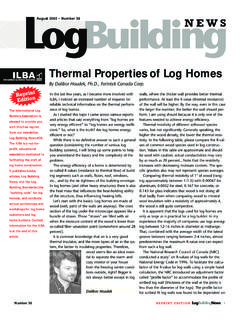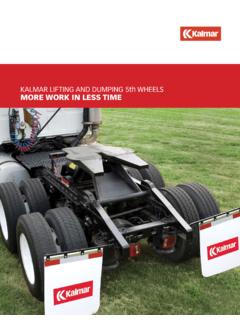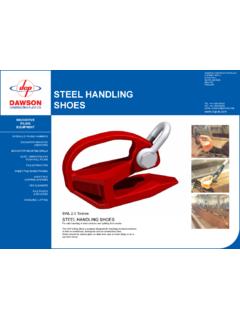Transcription of Lifting and Moving Equipment Section I. Lifting …
1 FM 5-125 CHAPTER 5 Lifting and Moving EquipmentSection I. Lifting EquipmentEquipment used for Lifting includes ginincludes pole, brave, and jinniwink der-poles, tripods, shears, boom derricks, leg derricks. Light hoisting equipmentGIN POLESA gin pole consists of an upright spar that isguyed at the top to maintain it in a verticalor nearly vertical position and is equippedwith suitable hoisting tackle. The verticalspar may be of timber, a wide-flange steel-beam Section , a railroad rail, or similarmembers of sufficient strength to supportthe load being lifted. The load may behoisted by hand tackle or by hand- orengine-driven hoists. The gin pole is usedwidely in erection work because of the easewith which it can be rigged, moved, andoperated.
2 It is suitable for raising loads ofmedium weight to heights of 10 to 50 feetwhere only a vertical lift is required. Thegin pole may also be used to drag loads hori-zontally toward the base of the pole whenpreparing for a vertical lift. It cannot bedrifted (inclined) more than 45 degrees fromthe vertical or seven-tenths the height ofthe pole, nor is it suitable for swinging theload horizontally. The length and thicknessof the gin pole depends on the purpose forwhich it is installed. It should be no longerthan 60 times its minimum thicknessbecause of its tendency to buckle under com-pression. A usable rule is to allow 5 feet ofpole for each inch of minimum 5-1, page 5-2, lists values when usingspruce timbers as gin poles, with allow-ances for normal stresses in hoisting GIN POLESIn rigging a gin pole, lay out the pole withthe base at the spot where it is to beerected.
3 To make provisions for the guylines and tackle blocks, place the ginpole on cribbing for ease of lashing. Figure4-18, page 4-16, shows the lashing on top ofa gin pole and the method of attachingguys. The procedure is as follows:Make a tight lashing of eight turns offiber rope about 1 foot from the top ofthe pole, with two of the center turnsengaging the hook of the upper blockof the tackle. Secure the ends of thelashing with a square knot. Nailwooden cleats (boards) to the poleflush with the lower and upper sidesof the lashing to prevent the lashingfrom out guy ropes, each four times thelength of the gin pole. In the center ofeach guy rope, form a clove hitch overLifting and Moving Equipment 5-1FM 5-125the top of the pole next to the tacklelashing.
4 Be sure to align the guy linesin the direction of their anchors (seeFigure 5-1).Lash a block to the gin pole about 2 feetfrom the base of the pole, the same asfor the tackle lashing at the top, andplace a cleat above the lashing to pre-vent slipping. This block serves as aleading block on the fall line, whichallows a directional change of pull fromthe vertical to the horizontal. A snatchblock is the most convenient type to usefor this the hoisting tackle, and use theblock lashed to the top of the pole sothat the fall line can be passed throughthe leading block at the base of the a stake about 3 feet from thebase of the gin pole. Tie a rope fromthe stake to the base of the pole belowthe lashing on the leading block andnear the bottom of the pole.
5 This pre-vents the pole from skidding while youerect all lines to be sure that they arenot snarled. Check all lashings to seethat they are made up properly andthat all knots are tight. Check thehooks on the blocks to see that they aremoused properly. You are now readyto erect the gin GIN POLESYou can easily raise a 40-foot-long gin poleby hand (see Figure 5-2). However, youmust raise longer poles by supplementaryrigging or power Equipment . The number ofpeople needed to erect a gin pole depends onthe weight of the pole. The procedure is asfollows:Dig a hole about 2 feet deep for thebase of the gin LIftlng and Moving EquipmentFM 5-125 Lifting and Moving Equipment 5-3FM 5-125 String out the guys to their respectiveanchorages and assign a person to eachanchorage to control the slack in theguy line with a round turn around theanchorage as the pole is raised.
6 If ithas not been done already, install ananchorage for the base of the the tackle system that was used toraise and lower the load to assist inraising the gin pole, if necessary; how-ever, the preferred method is to attachan additional tackle system to the rearguy line. Attach the running block ofthe rear guy-line tackle system to therear guy line, the end of which is at thispoint of erection near the base of thegin pole (see Figure 4-18, page 4-16).Secure the fixed or stationary block tothe rear anchor. The fall line shouldcome out of the running block to givegreater MA to the tackle the tackle system to the base ofthe gin pole before erecting it to pre-vent the tackle blocks from in on the fall line of the tacklesystem, keeping a slight tension on therear guy line and on each of the sideguy lines, while eight people (more forlarger poles) raise the top of the pole byhand until the tackle system can takecontrol (see Figure 5-2, page 5-3).
7 Keep the rear guy line under tension toprevent the pole from swinging andthrowing all of its weight on one of theside all guy lines to their anchor-ages with the round turn and two halfhitches when the pole is in its finalposition, approximately vertical orinclined as desired. At times, you mayhave to double the portion of rope usedfor the half the leading block at the base ofthe gin pole and place the fall line fromthe tackle system through it. Whenthe leading block is closed, the gin poleis ready for you have to driftthe top of the pole without Moving thebase, do it when there is no load onthe pole, unless the guys are equippedwith GIN POLESThe gin pole is particularly adapted to verti-cal lifts (see Figure 5-3).
8 Sometimes it isused for Lifting and pulling at the same timeso that the load being moved travels towardthe gin pole just off the ground. When usedin this manner, attach a snubbing line ofsome kind to the other end of the load beingdragged; keep it under tension at all tag lines to control loads that you arelifting vertically. A tag line is a light linefastened tounder slightone end of the load and kepttension during tripod consists of three legs lashed orone-half times that of shears made of thesecured at the top. The advantage of the tri-same size over other rigging installations is thatit is stable and requires no guy lines tohold it in place. Its disadvantage is that theRIGGING TRIPODS load can be moved only up and down.
9 TheThe two methods of lashing a tripod, eitherload capacity of a tripod is about one andof which is suitable provided the lashing5-4 Lifting and Moving EquipmentFM 5-125 Lifting and Moving Equipment 5-5FM 5-125material is strong enough, are discussedbelow. The material used for lashing can befiber rope, wire rope, or chain. Metal ringsjoined with short chain sections and largeenough to slip over the top of the tripod legsalso can be 1 This method is for fiber rope, 1 inch in diam-eter or smaller. Since the strength of the tri-pod is affected directly by the strength of therope and the lashing used, use more turnsthan described here for extra heavy loadsand fewer turns for light loads.
10 The proce-dure is as follows:Select three spars, about equal in size,and place a mark near the top of eachto indicate the center of the two of the spars parallel with theirtops resting on a skid or block and athird spar between the first two, withthe butt in the opposite direction andthe lashing marks on all three in spacing between spars should beabout one-half the diameter of thespars. Leave space between the sparsso that the lashing will not be drawntoo tight when erecting the a clove hitch (using a l-inchrope) around one of the outside sparsabout 4 inches above the lashing mark,and take eight turns of the line aroundthe three spars (see Figure 5-4, A). Besure to maintain the space between thespars while making the the lashing by taking two closefrapping turns around the lashingbetween each pair of spars.







